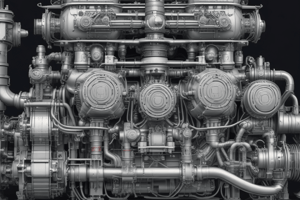Podcast
Questions and Answers
What is the purpose of the crankshaft in an internal combustion engine?
What is the purpose of the crankshaft in an internal combustion engine?
- To convert the up-and-down motion of the pistons into rotary motion (correct)
- To ignite the air-fuel mixture
- To control the flow of air and fuel into the cylinders
- To generate power by burning fuel
What is the function of the valves in an internal combustion engine?
What is the function of the valves in an internal combustion engine?
- To control the flow of air and fuel into the cylinders and exhaust gases out of the cylinders (correct)
- To convert the up-and-down motion of the pistons into rotary motion
- To compress the air-fuel mixture
- To generate power by burning fuel
What is the result of the power stroke in the four-stroke cycle?
What is the result of the power stroke in the four-stroke cycle?
- The piston moves downward, generating power (correct)
- The intake valve closes
- The exhaust valve opens
- The air-fuel mixture is compressed
What type of engine uses a spark plug to ignite the air-fuel mixture?
What type of engine uses a spark plug to ignite the air-fuel mixture?
What happens during the intake stroke in the four-stroke cycle?
What happens during the intake stroke in the four-stroke cycle?
What is the purpose of the cylinders in an internal combustion engine?
What is the purpose of the cylinders in an internal combustion engine?
Study Notes
Overview
- An internal combustion engine is a type of engine that generates power by burning fuel, typically gasoline or diesel, inside a combustion chamber within the engine.
- It is a key component of most modern vehicles, including cars, trucks, and motorcycles.
Basic Components
- Cylinders: Chambers where the fuel is burned and the power is generated.
- Pistons: Moving parts that reciprocate in the cylinders, driven by the explosive force of combustion.
- Crankshaft: Converts the up-and-down motion of the pistons into rotary motion.
- Camshaft: Operates the valves that allow air and fuel into the cylinders and exhaust gases out of the cylinders.
- Valves: Control the flow of air and fuel into the cylinders and exhaust gases out of the cylinders.
Four-Stroke Cycle
- Intake stroke: Air and fuel are drawn into the cylinder through the intake valve.
- Compression stroke: The intake valve closes, and the air-fuel mixture is compressed by the piston.
- Power stroke: The spark plug ignites the air-fuel mixture, causing the piston to move downward.
- Exhaust stroke: The exhaust valve opens, and the piston pushes the exhaust gases out of the cylinder.
Types of Internal Combustion Engines
- Spark Ignition Engine: Uses a spark plug to ignite the air-fuel mixture, commonly used in gasoline-powered vehicles.
- Compression Ignition Engine: Uses the heat generated by compressing air to ignite the fuel, commonly used in diesel-powered vehicles.
- Rotary Engine: Uses a rotary design instead of traditional pistons and cylinders, commonly used in some sports cars.
Advantages and Disadvantages
Advantages:
- High power-to-weight ratio
- Low cost
- Wide range of fuel options
Disadvantages:
- Low efficiency
- High emissions
- Noise and vibration
Studying That Suits You
Use AI to generate personalized quizzes and flashcards to suit your learning preferences.
Description
Test your knowledge of internal combustion engines, including their components, four-stroke cycle, and types such as spark ignition and compression ignition engines. Learn about the advantages and disadvantages of internal combustion engines.





